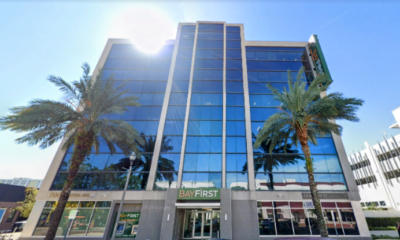Thrive
Developers may face new requirements in CBA process

The future redevelopment of the former Gas Plant District and other transformative projects on city-owned land must meet criteria under the established Community Benefits Program – but now those developers may be subject to meet new requirements.
Community Benefits Agreements (CBAs) are used by many cities as a tool for economic equity. It creates a process that takes into account the social and community impact of a development plan.
An unsolicited proposal submitted last year for a Moffitt Cancer Center site, which was tied to a housing project, parking garage and hotel development at the 800 Block, was the first project the Community Benefits Advisory Committee (CBAC) reviewed.
St. Petersburg Mayor Ken Welch said the joint venture team didn’t include enough affordable housing for the residential component, and the purchase offer was far below the property’s appraised value. Although the project ultimately never came to fruition, the CBAC review process left developers and the public with remaining questions and concerns.
During a two-hour-long Monday CBAC meeting, Jason Mathis, CEO of the St. Petersburg Downtown Partnership, said the process was too cumbersome.
It was nine months since the council last met and debriefed about the CBAC’s review process on the Moffitt/TPA deal.
The CBAC is now focused on making the process more efficient for all stakeholders and updating the language in the program.
City Director of Economic and Workforce Development Brian Caper presented slides to the group of the new recommended amendments, including:
- New affordable housing requirements: The members discussed amending the language to require that developers proposing any residential component of a project must dedicate at least 40% of the housing units to workforce/affordable housing. Caper mentioned that if a developer can’t deliver the dedicated unit count, they must contribute $50,000 per unit to the CBA fund. Those proceeds would then go toward affordable housing elsewhere in the city. “I do think it depends on the location in downtown. It may incentivize developers to make payment in lieu of the units,” Caper said. For example, if the Moffitt project moved forward and opted out of setting aside affordable units, the group would have to pay $16.5 million. “We want to provide some flexibility. We know not every project is going to pencil out the same,” Caper said. The CBAC may also revise the required AMI (average median income) levels.
- Providing the report: The CBAC may recommend that developers should provide the impact report first and foremost, which would address any questions regarding the benefits, wage levels and any disruptions a project may have on nearby businesses.
- Elimination of exemptions: Caper explained developers and the public found the exemptions confusing and the CBAC should instead offer a streamlined process.
- Business participation from minorities: There is a 10% SMBE (Small Minority Business Enterprise) participation requirement. Caper said every project varies, but developers should strive for a 30% goal.
- LEED certification alternative: Caper said the city has heard from developers that they do not object to constructing LEED Silver-certified buildings (a LEED certification is a green building rating, recognizing a development built with sustainable materials); however, to be certified, there’s a large cost that Caper said is a “dis-incentive,” and he recommends that the city could instead review the same or similar standards and the developer wouldn’t have to cut a check. Projects in certain zoning categories would be required to have on- or off-site parking. With projects for the Deuces corridor, such as the Sankofa project and redevelopment of the Manhattan Casino, Chair member Gypsy Gallardo said the major challenge is parking and revised plans do not address the parking issues. “Some thought needs to go into how we accommodate the type of growth we want to see as opposed to the hodgepodge gap-tooth, single-story smaller retail plazas, etc.,” she said.
Inapplicable projects
A project that generates at least 300 new jobs in one of the city’s targeted industries and pays at least 150% of Pinellas County’s annual average wage, or above $81,000, can bypass the CBAC approval process.
“Having that project is in the hundreds of millions of dollars in terms of economic impact to the community,” Caper said. “These new jobs add a lot of buying power.”
The average wage in the county is just over $52,000.
Gallardo asked if the Gas Plant District redevelopment, which would generate thousands of jobs, is subject to CBAC review.
“I don’t believe they would hit the 150% [wage mark], but we do have a current ordinance that says that the project is required to go through the CBA process,” Caper said.
The planned ballpark the Tampa Bay Rays and Hines team are expected to construct will not have to be approved by the CBAC, as Pinellas County will own the stadium, Caper said.
Similar to the St. Pete Pier and the new Police HQ, the city has a completely different set of ordinances. The stadium project would still need to meet certain thresholds, including SMBE participation and job creation.
The ripple effect
Through the conversation of job creation for locals and opportunities for minorities, the topic of gentrification emerged.
“How are my people, Black people specifically, advanced through this as the most economically compromised?” Gallardo said. Caper said Dynasty Financial Partners was the area’s biggest “get,” relocating workers from its New York office while also hiring locals.
“Local hiring doesn’t address my concern of inclusivity for historically disadvantaged people to scale up,” Gallardo said.
Member Bruce Nissen also shared similar concerns.
Next steps
The recommendations will go before the city for review June 15. The city staff can advise the amended ordinance, which will then be presented to the council by the late summer.
The CBAC is not reviewing a specific project at this time.








Alan DeLisle
June 10, 2023at12:01 pm
The problem is that the program does not value aggregate benefits to the city. If you were to add up the value of the affordable housing, the public parking and the jobs, the original Moffitt project far surpassed the gap in the purchase price. Putting ridiculously high requirements on one value negates other important economic values to the community. Quality economic development gives you the flexibility to be honest about values and needs. Successful cities do not just do one thing. I give high marks to the Citizens Committee for originally understanding this and approving the Moffitt deal. Cancelling the Moffitt deal was a huge mistake.
S. Rose Smith-Hayes
June 8, 2023at3:57 pm
The CBAC has not met for 9 months?? Did I read that correctly???
Where can I find the criteria for this entity???They should meet at least once a quarter unless a project requires more meeting time.